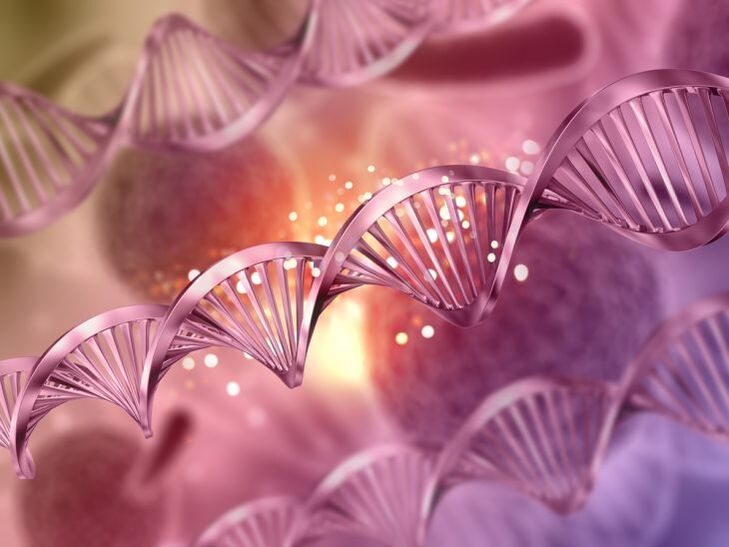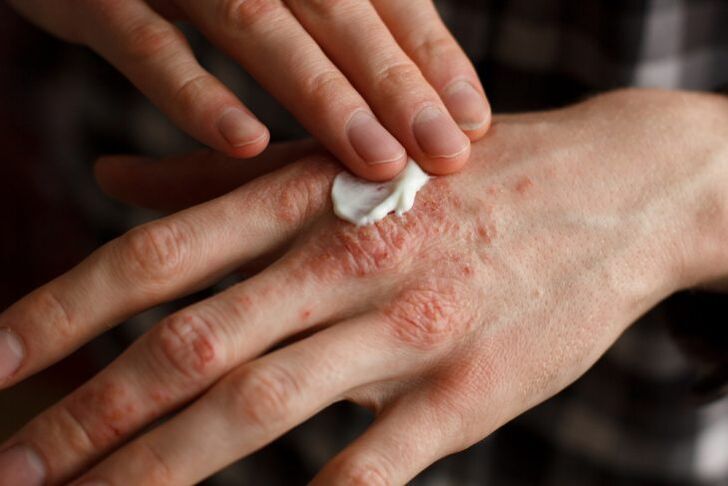Psoriasis also known as scaly lichen in children is a chronic disease that is manifested by the formation of silvery white papules (acne) on the skin of children. The prevalence of psoriasis among all dermatological diseases is about 8%. This disease occurs in different groups of children of different ages, including newborns and infants, and is common in girls. The disease is characterized by a number of seasonal properties: in winter there are more cases of psoriasis than in summer.
The disease is not contagious, although theories about the origin of the virus are still under consideration.
Cause of disease

The normal maturation cycle of skin cells is 30 days. In psoriasis, it shrinks to 4-5 days, manifested by the formation of psoriatic plaques. By electron microscopy, it was found that the changes were the same in the healthy skin of the child as in the affected areas. In addition, in patients with psoriasis, disruptions in the functioning of the nervous, endocrine, immune systems, metabolism (mainly enzymes and fats) and other changes inbody is revealed. This suggests that psoriasis is a systemic disease.
There are three main groups of causes of psoriasis:
- heredity;
- Wednesday;
- infection.
Genetics is a leading factor in the development of psoriasis. This is confirmed by research on dermatophytosis occurring in twins, relatives within several generations, as well as biochemical studies of healthy family members. If one parent has psoriasis, the probability that the child will have psoriasis is 25%, if both have the disease is 60-75%. At the same time, the type of inheritance remains unclear and is recognized as multifactor.
Environmental factors include seasonal changes, contact of clothing with skin, impact on children's psychological stress, relationships with peers. Focusing the attention of the children in the group on a sick child, treating them like a "black sheep", limiting contact for fear of infection - all these factors can causenew exacerbations, increasing the area of damaged skin. A child's psyche is especially vulnerable during puberty, which is due to hormonal changes. Therefore, a large proportion of disease detection falls in the teenage years.
The proportions of genetic and environmental factors that trigger the onset of psoriasis are 65% and 35%.
Infections trigger allergic response mechanisms because infections can trigger the development of psoriasis. Therefore, the disease can occur after the transfer of influenza, pneumonia, pyelonephritis, hepatitis. Even the post-infectious form of the disease is distinguished. It is characterized by a multiple papule rash in the form of drops all over the body.
In some cases, the onset of psoriasis precedes skin trauma.
Symptom
Psoriasis is characterized by the skin appearance of a rash as small red islets ("plaques") with silvery-white patches that are flaky and itchy. The appearance of cracks in the plaques may be accompanied by mild bleeding and accompanied by secondary infection.
Externally, psoriatic rashes in children are similar to those in adults, but there are some differences. For children with psoriasis, Koebner's syndrome is very characteristic - the appearance of a rash in areas affected by irritation or trauma.
The course of psoriasis in children is prolonged, with the exception of the teardrop form, which is more favorable. There are three stages of the disease:
- progressive;
- freeze;
- recession.
The advanced stage is characterized by the formation of small pruritic papules surrounded by a red rim. Lymph nodes may become enlarged and thickened, especially in severe psoriasis. In the quiescent phase, the growth of the rash stops, the center of the patches flattens out, and the flaking subsides. In the regressive stage, the elements of the rash dissolve, leaving a depigmented rim (Voronov's ring). The rash leaves hyperpigmented or hypopigmented nodules.
Localization of psoriatic eruptions may vary. Usually, the skin on the elbows, knees, buttocks, navel, scalp is affected. Every third child with psoriasis has affected fingernails (the so-called prickly nail symptom, in which small holes appear in the nail plates, resembling fossils of thorns). Plaques can often be found in the folds of the skin. Mucous membranes, especially the tongue, are also affected, and the rash may vary in location and shape ("geographic tongue"). The skin of the palms and the skin of the feet is characterized by hyperkeratosis (thickening of the upper layer of the epidermis). The face is less often affected, the rash appears on the forehead and cheeks, can spread to the ears.
In blood analysis, an increase in total protein and gamma globulin levels, a decrease in the albumin-globulin coefficient and violations of fat metabolism were detected.
Types of psoriasis in children
- teardrop-shaped;
- plaque;
- pustules;
- red blood cells;
- psoriasis of the newborn;
- psoriatic arthritis.
The most common form isteardrop psoriasis. . . It manifests itself in the form of red papules on the body and limbs, appearing after minor trauma, as well as after infections (otitis media, nasopharyngitis, flu, etc. ). In the swab, cytology showed streptococci. The teardrop form of psoriasis is often confused with an allergic reaction.
Plaque psoriasis is characterized by well-defined erythematous nodules with a thick white scab.
The pustular, or pustular, form is rare. The appearance of pustules can be triggered by infection, vaccinations, use of certain medications, stress. Pustular psoriasis that occurs in infants is called neonatal psoriasis.
With erythrodermic psoriasis, the child's skin looks completely red; Some areas of the skin may have plaque. Usually, skin manifestations are accompanied by increased body temperature and joint pain.
Psoriasis and erythrocytosis may present in generalized forms with a severe course of the disease. They require hospital treatment to avoid death.
Infantile psoriasis is also known as diaper psoriasis. Diagnosis is difficult because skin lesions most commonly occur in the buttocks area and can be confused with dermatosis due to skin irritation with urine and feces.
Psoriatic arthritis affects about 10% of children with psoriasis. The joints are swollen, the muscles are stiff, there is pain in the toes, ankles, knee joints, wrist joints. Conjunctivitis is often associated.
Usually, the course of any form of the disease changes every three months. In the summer, due to sun exposure, symptoms usually subside.
The treatment

It is best to first bring your child to the hospital for treatment of psoriasis.
- Desensitization drugs are prescribed (5% calcium gluconate solution or 10% calcium chloride solution inside, 10% calcium gluconate solution intramuscularly) and sedatives (Traditional tincture, valerian).
- When itching is severe, antihistamines and sedatives are appropriate.
- B vitamins are given intramuscularly in 10-20 injections: B6 (Pyridoxine), B12 (Cyanocobalamin), B2 (Riboflavin); Inside: B15 (pangamic acid), B9 (folic acid), A (Retinol) and C (ascorbic acid).
- To activate the body's defenses, people use drugs with thermogenic properties (increasing temperature). They normalize vascular permeability and reduce the rate of epidermal cell division.
- Weekly blood transfusion, plasma and albumin introduction.
- If treatment is not effective, as well as in severe cases, the doctor may prescribe glucocorticoids for a course of 2-3 weeks, the dose is gradually reduced and the drug is stopped. Dosage is selected individually. Cytostatics are not prescribed to children due to their toxicity.
- To combat plaque on the palms and soles, a occlusive dressing (sealing) with salicylic, sulfuric ointment is used.
- During the cessation and remission of psoriasis, children are prescribed UFOs, sedative baths, herbal remedies. The proven saponin extract itself, is used in the form of applications or baths.
When colds are often accompanied by psoriasis, it is necessary to clean the sources of infection: treat wisdom teeth, deworming, if indicated, cut the tonsils and cut the gland. A desirable step in psoriasis treatment is a spa treatment.
It must be remembered that psoriasis is a chronic disease characterized by periods of exacerbation and remission, and be prepared for long-term and frequent treatment.
Children need to practice a healthy lifestyle, teach them to cope with stress, and calmly deal with attacks by peers. The situation is particularly difficult for children whose facial skin is affected. All family members should support the sick child, this will help the child avoid guilt and grow up as a socially adjusted person.
Which doctor to contact?
Psoriasis in children is treated by a dermatologist. If not only the skin is affected, but also the joints, a consultation with a rheumatologist is indicated, with the development of conjunctivitis - an ophthalmologist. It is necessary to clean the foci of chronic infection by visiting a dentist, an infectious disease specialist, an otolaryngologist. If you are having difficulty making a differential diagnosis of psoriasis and allergies, you should contact an allergist. A nutritionist, physiotherapist, and psychologist assist with the patient's treatment.

























